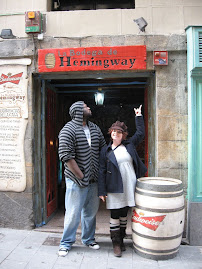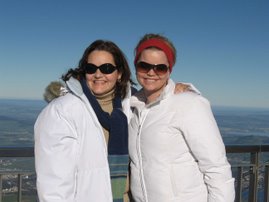Chapter 2: "Constructing Autism: A Dialectic of Biology and Culture, Nature and Mind"
Nadesan's purpose in this chapter is to explore "how socially constructed standards of normalcy embedded in cultural values and practices not only shape our interpretations of autism but also contribute to the production and transformation of people labeled with the disorder" (9).
"biological diseases, particularly autism, are the clinical practices developed to 'cure' them are fundamentally cultural in origin and remediation" (Nadesan 9).
Over the next 3 pages, Nadesan describes how Leo Kanner and Hans Asperger developed their theory of autism and Asperger's syndrome. A good place for historical material for backgrounding discussion in dissertation. (pages 10-13)
"In 1981 Asperger's work was introduced to a wider audience through Lorna Wing's essay 'Asperger's syndrome: a clinical account' published in the journal, Psychological Medicine" (Nadesan 13). A good definition (to supplement or explain DSM's) is also provided...
"a simple answer to what autism is, that is, what constitutes its essence, is unattainable" (Nadesan 14).
"overly educated mother" (Nadesan 18)
"the emergence of autism as a diagnostic category in the 1940s must be understood in relation to a matrix of professional and parental practices marking the cultural and economic transition to the twentieth century just as the popularization of high-functioning forms of autism must be understood in terms of the matrix of practices that mark late-twentieth century and early-twenty-first century life" (Nadesan 19).
conditions rooted in "cultural practices and economy of their times" (Nadesan 19).
"This raises questions about the relationship between the biological and the cultural, about the relationship between disease and social representation" (Nadesan 19). A statement particularly relevant for autism... Also, have to know what "normal" is to know what "abnormal is"
"In the search for its essence, the being of autism, researchers debated whether autism is a psychological disorder of the ego attachment (e.g., Bettelheim 1967), a biological disorder of the brain or metabolism (e.g., later Kanner), a personality disorder (e.g., Asperger), or some combination. [...] The implicit but dominant model seems to be that there is a visual-spatial-topological autistic center that will ultimately be discovered. This view of autism implicitly invokes a model of medicine in which disease is ontological, a thing in itself, which can be distinguished from the afflicting patient whose ontological status is unrelated to the disabling disorder" (Nadesan 20). Bakhin's chronotope
"disease is represented in our everyday understanding as available to 'empirical' identification, interpretation, and intervention. This everyday understanding of disease is partially rooted in nineteenth-century 'positivistic' thought holding that humankind can identify and understand the laws of nature unequivocally through detached empirical inquiry" (Nadesan 20). DAN protocol
"Positivistic conceptions of medicine presume a mind-body dichotomy in which diseases are primarily if not exclusively located in the biological body and presume that each disease is caused by a specific and ultimately, identifiable element" (Nadesan 20). Need an agent of harm...
"David Armstrong's (2002) A New History of Identity takes a moderated social construction approach in tracing changing perceptions of the origin and treatment of disease. Armstrong is less concerned with the biological reality of disease than in the representational practices used to identify, diagnose, and cure it" (Nadesan 21). [ILL'ed]
Armstrong argues that "prior to the nineteenth century, disease was understood to be found in the weather, the soil, and various aspects of the physical environment" (in Armstrong 58, from Nadesan 21). "However, medicine in the late eighteenth and early nineteenth centuries began to localize disease in the form of a 'pathological lesion, a specific abnormality of structure (or later, function) situated somewhere in the corporal space'" (in Armstrong 58, from Nadesan 21). I noted in my margins after reading that this might also apply to current discussions on autism.
new regime that "demarcated the diseased body from its environment" (Nadesan 21).
"Armstong's account of changing conceptions about the nature and origin of disease [...] highlights how social beliefs, values, and institutions influence medical practice" (Nadesan 21).
"Is culture merely the clothing within which the diseased body appears? Or, does culture--through its practices of hygiene and diet and through its medical vocabularies and institutions--produce disease in its entirety?" (Nadesan 21).
Nadesan and Grinker (amongst others) have focused on the construction and identification of autism in the 18th and 19th centuries. Trent focuses on the construction of mental retardation in the mid to late 19th century in America. However, in my dissertation, I think a large scholarly "hole" that is missing is the "epidemic" of autism that seems to have occurred following Beddleheim's book until the present. An examination of the events that have led to this so-called "epidemic" that can be traced from the 1960's to the present. A quote that would support this statement:
A study of autism during the twentieth century notes that autism was "[d]erived in relation to schizophrenia," as such "autism was first thought to be organic in nature. However, psychoanalytic thought was becoming increasing popular in North America and Europe at the time that Kanner first identified and labeled autism. Thus, the ascendancy of psychoanalytic thought, soon after the formalized identification of autism as a distinct disorder, led to speculation that psychic distress brought on by 'frigid mothering' caused autistic symptoms. [...] Today, however, the pendulum has again swung in the direction of organic causes, although contemporary causal agents may be considered exogamous (e.g., mercury poisoning) as well as endogamous (e.g., genetics)" (Nadesan 22).
"to emphasize the biological component of autism can lead to a devaluation of psychologically based therapeutic interventions such as behavioral modification therapy [...] or 'play therapy' rooted in psychoanalysis. The social construction of 'ideas' about the origin and remediation of the 'autistic' patient is imbued with material consequences" (Nadesan 23).
The Social Construction of What? I. Hacking describes "interactive kinds" and "indifferent kinds"--"interactive kinds" are "affected by the process of classification to such a degree that classification may require eventual modification or replacement" (Nadesan 24). "Interactive kinds are classifactory systems that emerge within complex matrices of institutions and practices" (Nadesan 24). "effect of producing what was classified" (24)
"biolooping" (24)
"Psychotropic drugs increase the ability of those classified as schizophrenic to reflect actively upon their diagnoses, leading to potential transformations in their disorder through their interpretive engagement with it" (Nadesan 25). Point to note: Performative aspect of biolooping
Autism "is a particularly compelling example of the intersection of biology and culture because although it is arguably an interactive kind, it also evidences the characteristics of an indifferent kind in that its symptoms are in some way rooted in genetics or molecular chemistry" (Nadesan 25).
The remainder of Nadesan's book argues that autism is a "disorder that emerged and was created in relation to cultural practices and discourses specific to particular points in time, the transition from the nineteenth to the twentieth centuries and, more recently, the transition from the twentieth to the twenty-first centuries" (Nadesan 26).
Saturday, July 7, 2007
Subscribe to:
Post Comments (Atom)








No comments:
Post a Comment